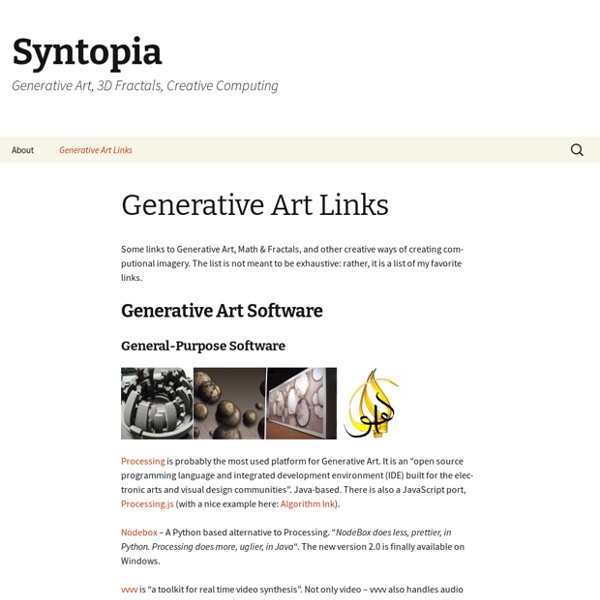



Context Free Art Generative Art International Conference Distance Estimated 3D Fractals (III): Folding Space The previous posts (part I, part II) introduced the basics of rendering DE (Distance Estimated) systems, but left out one important question: how do we create the distance estimator function? Drawing spheres Remember that a distance estimator is nothing more than a function, that for all points in space returns a length smaller than (or equal to) the distance to the closest object. This means we are safe to march at least this step length without hitting anything – and we use this information to speed up the ray marching. It is fairly easy to come up with distance estimators for most simple geometric shapes. For instance, let us start by a sphere. (1) DE(p) = max(0.0, length(p)-R) // solid sphere, zero interior (2) DE(p) = length(p)-R // solid sphere, negative interior (3) DE(p) = abs(length(p)-R) // hollow sphere shell From the outside all of these look similar. What about the first two? From left to right: Sphere (1), with normal artifacts because the normal was not backstepped.
Create striking graphics: Part 2 Following on from Part 1, we explore how to set abstract shapes from some simple patterns, using a geometric and conceptual approach. Treatment in Photoshop enables us to build our scene correctly and also texture the image. Layer options are applied to achieve quick results and generate multiple effects, while creating minimalist designs. Let’s continue… Extend axes to increase symmetry To signify the geometry and direction of the collision that we are portraying, we’ll add grey lines (2px Stroke) that will lengthen existing angles, making three axes. Group graphic layers to modify We’ll edit our shapes and make small modifications to any of the groups containing graphical elements. Be critical Erase all those small details that break the symmetry or differ from the geometric criterion. Balance design and add more text Place smaller text in the bottom-right corner of your canvas. Text style and location Apply triangles Insert data Add shadow Shadow placement Illuminate elements Apply a vignette
m e d u l . l a / b l o g ¿qué significa historiar hoy? ¿cómo los mecanismos de almacenamiento y transmisión de información modifican la manera como opera la memoria humana? estas son algunas de las cuestiones que el proyecto loci intenta plantear. el nombre se viene del sustantivo plural del termino en latín locus, que se puede asociar a un largo conjunto de conceptos, como lugar, situación, estado. el proyecto fue presentado en el sábado, 16 de julio, en el espacio de memoria la perla, como parte de mi participación en la residencia del proyecto demolición/construcción. aún en desarrollo, la aplicación web fue presentada como prototipo para su discusión en conjunto con los demás artistas y pensadores participantes. más detalles cuanto al proceso de desarrollo serán revelados luego. es también de mi intención publicar acá un texto que soporta conceptualmente algunas de las cuestiones tratadas por el proyecto (conforme anuncié un par de semanas atrás).
Fractal Zoomer - Explore the Mandelbrot fractal Syntopia | Generative Art, 3D Fractals, Creative Computing basil.js // Geometrie 1 « Ending the Depression through Amazon-linking-words- »Various designers Results of the foundational introduction course into Generative Design with basil.js at the Visual Communication Institute in basel by Martin Fuchs and Ludwig Zeller. Pascal Imhof The brief of this first year seminar at the Visual Communication Institute in Basel is to design a cover for a fictional book about Generative Design entitled “Geometrie 1″. Cyrill Studer Lazar Jeremic Sarah Sbalchiero